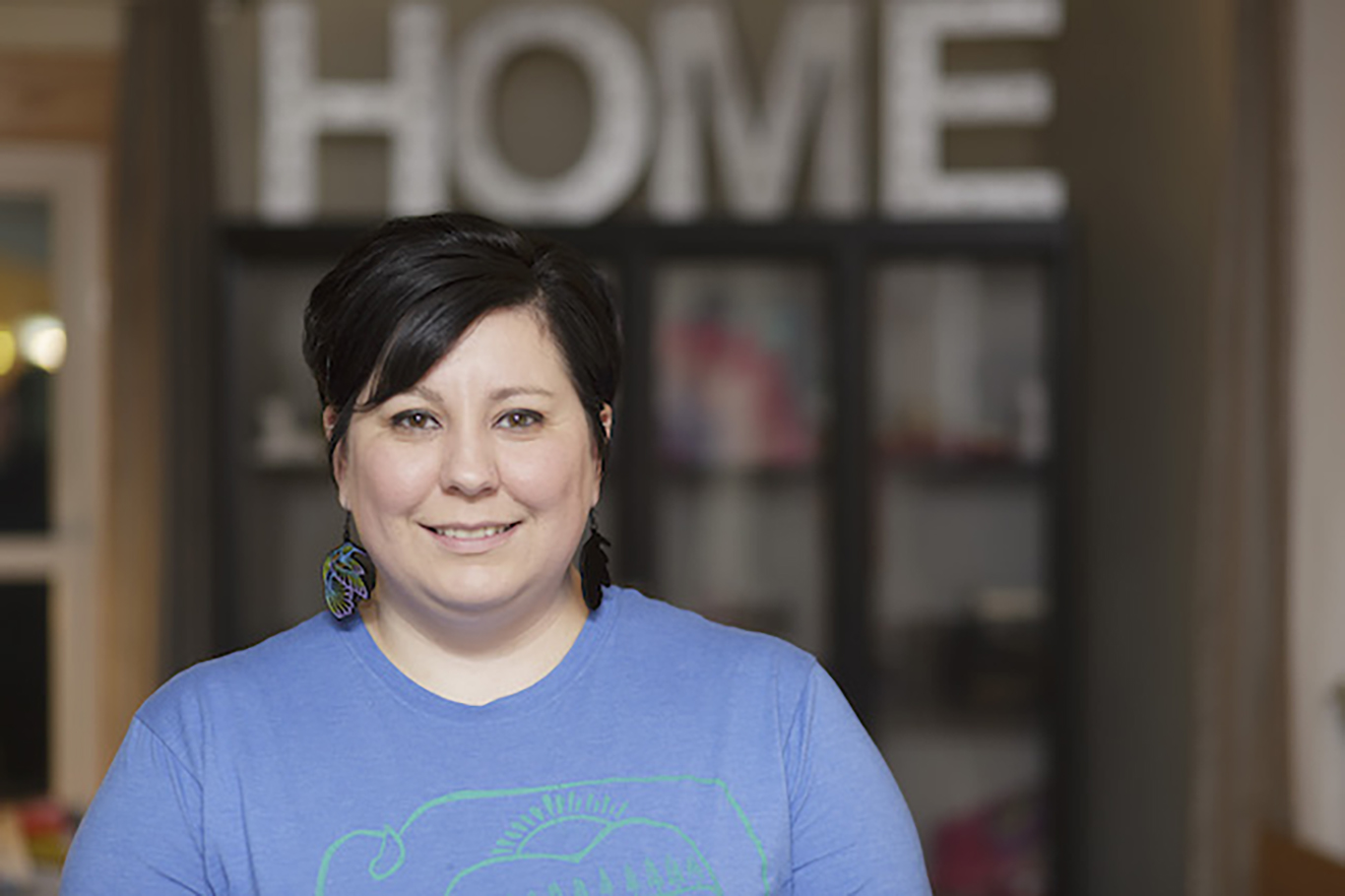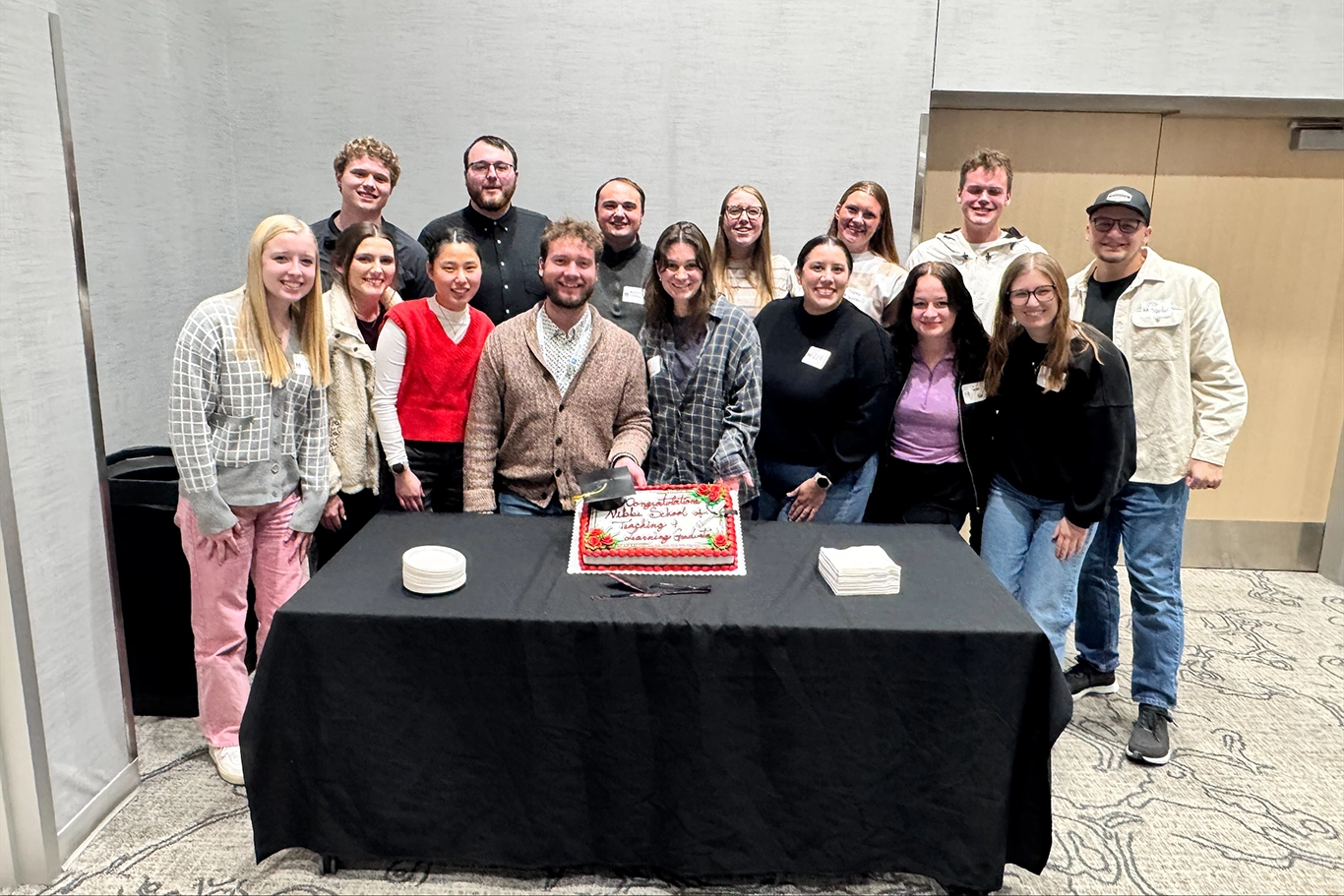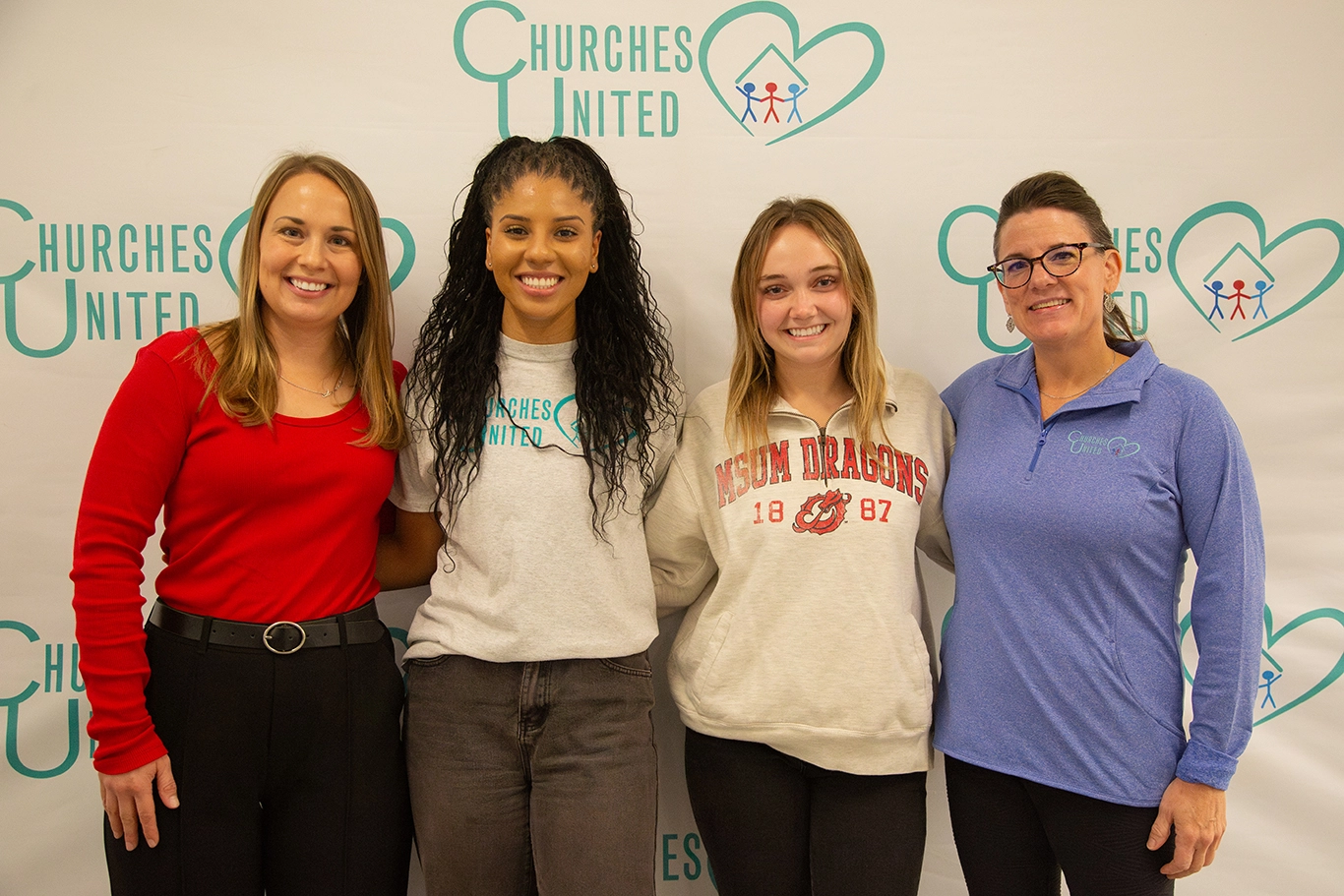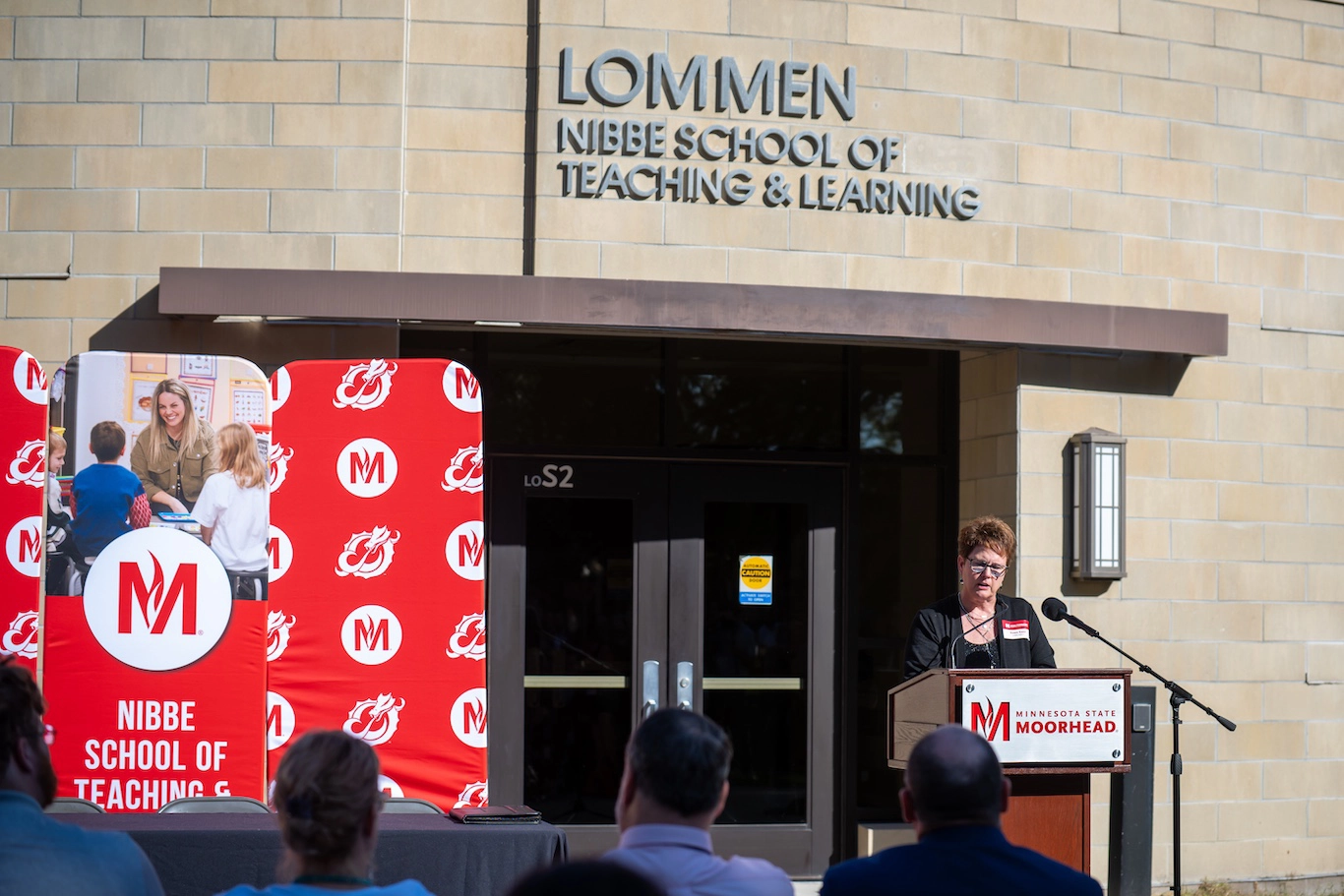Circles of community contribute to master's success
Photo: L to R: Caitlin Johnson, Frank Williams, Stephanie Allery, Jordan Dionne, Michelle Delorme, Michael Laducer, and LeAnn Williams
Six-student Ojibwe cohort earns degrees in curriculum and instruction
The students stand in a circle, the scent of burning sage tickling their nostrils, the beat of drums filling the physical space around them. The smoke fills the spiritual space within them, as well, through their ears, eyes and hearts, bringing peace in anticipation of one of the biggest days of their lives.
Dr. Caitlin Johnson, herself a member of the Turtle Mountain Band of Chippewa (Ojibwe), holds a bowl with the sage leaves smoldering inside. Arlan Littlewolf, a Plains Ojibwe spiritual leader and Indian education liaison in the Moorhead (Minn.) Public Schools, offers prayers. The students' family members and friends stand outside the circle with university representatives as supporters and witnesses.
The smudging ceremony has begun.
As the smoke rises, negative energies and feelings are lifted away.
Johnson, a Minnesota State University Moorhead assistant professor of educational leadership, slowly and deliberately makes her way around the inside of the circle. Johnson stops before each of her fellow Ojibwe, who have been master's students under her guidance for the past 17 months.
They perform the ritual, sacred among many North American indigenous tribes, that is integral to observing, commemorating and celebrating significant events and accomplishments. It enables honorees and participants to slow down, center and ground themselves in the present moment.
One by one, the students - Stephanie Allery, Jordan Dionne, Michele Delorme, Michael Laducer, Leann Williams and Frank Williams - pull smoke toward themselves, into their faces, up and over their heads and down their bodies in an act of cleansing.
Sage, which along with cedar, sweetgrass and tobacco is one of the four sacred medicines, or muskiiki, of the Ojibwe people, is appropriate for the occasion, Johnson says. "It neutralizes the energy of the room, purifies and attracts positive energy," she said. "Overall, smudging allows people to let go of negativity and can serve to send one's wishes or goals to the creator."
The ceremony marks the beginning of a full day, with a Department of Leadership and Learning hooding ceremony and the 2024 MSUM graduation coming soon after that. The six students will be receiving diplomas as masters in curriculum and instruction.
But in this moment, with the sage smoke permeating their beings, the six students are still a tight-knit community of Ojibwe in a moment of cleansing and reflection, preparing for a significant event not just in their lives, but the lives of their family members, broader communities and the entire Turtle Mountain Band.
We cleanse our minds so we can welcome good thoughts.

Dr. Caitlin Johnson, Assistant Professor of Educational Leadership
A fateful discussion nearly two years earlier, in the summer of 2022, brought them to this moment.
It started when Dr. Keith LaVallie, who was the Belcourt School District #7 human resources director at the time, contacted Johnson to pick her brain about potential professional development opportunities for district employees, specifically in the area of literacy. In 2020, the North Dakota Department of Public Instruction (DPI) had awarded the district a U.S. Department of Education Comprehensive Literacy State Development (CLSD) grant, with a portion of those funds to be dedicated to developing the district's educators.
LaVallie and Johnson already knew each other; she is a native of Belcourt and a member of the Turtle Mountain Band, and her first teaching job was in the Turtle Mountain Community High School.
"He was kind of shocked when I told him I teach literacy at MSUM, and the master's program was born right there," she recalls.
No one - neither Johnson, nor LaVallie, nor the school board members nor the superintendent, and certainly none of her six future master's degree students - could have predicted the passion of the community focus and collaboration that would result.
Johnson met with LaVallie and other district administrators often during the fall semester to do all of the logistical planning, develop the plan of study and summer residencies, and to outline what the program was going to look like for the students.
It was a welcome opportunity, said Johnson, who previously conducted research related to equity gaps in higher education. For example, she said, fewer than 1 percent of Native Americans hold graduate degrees.
"Because of the rarity, a lot of times our voices get ignored in educational issues, mainly because we lack research and education," she explained. "Also, when we look at statistics that are that low, meaning not significant or not high enough, we tend to glaze over them, and that's an issue when you are part of a marginalized group."
We cleanse our eyes so we can clearly see our path.
Developing a strong partnership between the school district and MSUM began with building trust.
"It's really about showing the community that you're invested in the partnership and building relationships because you need to be able to collaborate, share ideas, and work together," Johnson said. "You can't do that without having that established trust and those relationships."
Since she was part of the community, Johnson already had some of those relationships in place. The familiarity made it easier to seek out resources and solve problems that came up than it might have been for someone without the existing connections.
After several months of preparation and coordination between Johnson, MSUM, and district administrators, the master's program came into focus. DPI approved the plan and spending that covered all program costs, including the students' tuition, materials and fees. The only requirements were that an applicant needed to hold a bachelor's degree and be a full-time school district employee. They also had to agree to remain employed with the district for three years beyond completion of the master's degree.
The only other potential complicating factor was that they'd have to finish their studies quickly. Due to the parameters of the grant, the program needed to be completed and funds fully expended prior to Sept. 30, 2024. Given the rigorous requirements of the academic program, coupled with MSUM's semester schedule, that meant students needed to begin in January 2023 and finish prior to the end of the 2024 summer semester.
All that was still lacking was participants, so at the beginning of the winter holiday break in December 2022, the district sent an email to all of its employees to let them know about the opportunity.
We cleanse our ears so we can hear the good things coming into our lives.
It was a huge decision to make with only a few days to make it, but, as the students would do repeatedly over the next 18 months, they made it work.
To a person, they say the fact that Johnson was a tribal member and Belcourt native was a determining factor in their decision to take on a more-than-full-time academic load in addition to their full-time jobs and familial obligations.
"Life is very complicated, sometimes, on a reservation," said Leann Williams, who teaches in the elementary school. "A lot of other people don't understand the pull to take care of family and obligations that are just part of our culture. So I really looked forward to working with Dr. Johnson just because of the fact that she understands, and she had to get through it all, too."
Johnson's familiarity was also key for Allery, another elementary school teacher. "She knows our area and the culture, how our people learn best and how to meet our specific needs," she said. "Someone from outside might understand that too, but I don't know if they'd be as compassionate being they weren't from here."
It made it easier for district officials to commit to the program, as well, according to Levi Gourneau, who is the district's assistant superintendent and current human resources director.
"With a director who is Native American and someone from our community, there was a level of trust there that probably wouldn't have been there otherwise," he said. "We know Native American students do better in that kind of setting. Plus, with this cohort, they were surrounded by other students who are their own people and who work in the same school district, which made the situation that much more comfortable."
We cleanse our mouths so the words we speak come from kindness and compassion.
On a cold January day in 2023, with the warmth of that comfort level in their hearts, the six students in the Turtle Mountain cohort – one paraprofessional, one administrator and four teachers – got down to the work-read-study-research-write-record-repeat grind of a new life.
But they were far from alone. Rather, they all had the support of multiple circles of community, a circumstance that, in many ways, brought forward the traditions of the past.
"In the tribal setting, communities are the producers of education. When communities produce education, the groupings of the community reflect the charisma, wisdom, and activities of the various parts of the community.... In that way, the sacredness of the community can be protected and developed."
Vine Deloria, Jr., Native American Author, Theologian & University Professor
Delorme, who teaches Ojibwe culture in the elementary school, explains it this way:
"Each one of us belongs to a clan, and in the past each clan played a role in our community. Whether it was teaching or protecting or hunting, each citizen was productive in what they were doing. Our elders taught the stories and lessons to the little ones, and as they got older they started getting hands-on experience in the role they were going to play in the tribe or the village or the band. So it's definitely true that it takes a tribe to raise a child."
For Delorme and her Turtle Mountain cohort classmates, the sacredness of community was already evident in the mutual respect they shared with their program director, and it would continue to manifest in multiple ways over the coming weeks and months.
The students and the family and friends who helped them along the way formed a community, for example. Their respective clans were another. The Belcourt School District's other paraprofessionals, teachers, administrators and school board members formed another. The residents of Belcourt and surrounding Ojibwe communities, another. MSUM professors and students, yet another. The master's students' own students in Belcourt schools, who they continued to work with every day. The tribal chair and tribal council. The entire Turtle Mountain Band.
The district superintendent and HR director participated in some of the early planning calls, and the school board approved the program and funding. Colleagues stepped in to cover for the master's students at various points. Family members shared some of their responsibilities from time to time. And so on, with dozens of individual acts of assistance and support that were equally critical to their ultimate success.
"We have a lot of people who care," Leann Williams said simply. "They were really rooting for us."
The core community was, of course, the cohort itself.
"It got kind of overwhelming, but my cohort members were always there to listen and push each other, like, 'Come on, we can do this. You can do it. We can work together. We can help you,'" said Allery, who teaches math at the middle school. "Without my cohort members and without Dr. Johnson's support, without her guiding us the way she did, I seriously don't think I would've made it."
The students worked together through a wide range of topics and areas of study related to literacy, from public educational policy and citizen and parental pressures on school boards, administrators and teachers to brain development and external influences on how different people learn. Johnson designed the experience with maximum flexibility so each of the students could incorporate not only their interest areas, but also topics and practices they could apply directly in their classrooms even as they progressed toward their master's degrees.
While the program was mostly online so the students could continue working, some teaching and learning happened right in the community, as well. During the summer of 2023, Johnson and one of her colleagues, Dr. Marcie Glessner, associate professor in the MSUM School of Teaching & Learning, spent two weeks in Belcourt for an intensive residency that included courses and working with the master's students in their own classrooms. That, in turn, made it possible for Johnson to more closely tailor professional development to their needs.
In the summer of 2024, Johnson was back in Belcourt as the master's students presented their capstone projects to her and the school board. Per the school district's requirements, the projects centered on areas of need and emphasis in its strategic plan.
We cleanse our hearts so we can feel in a good way.
The primary beneficiaries of the master's program were, of course, the students themselves, but the positive effects spread from the cohort's center to the surrounding communities like ripples on a lake.
Pursuing master's degrees while working full time in the school district - that alone has had an impact.
"It extends beyond just being role models for their family and their own kids," Johnson said. "It's much more than that because they're serving as role models for the students they teach, as well, and that's big."
At the most basic level, the program is going to benefit the elementary, middle- and high-school students who learn under any of the new masters.
"So many of our students are very good communicators verbally, which is part of our culture," said Frank Williams, a paraprofessional who assists in classrooms throughout in the school system. "Our people are natural orators and storytellers, and we're passionate about teaching our students how to use those skills. We want them to buy in to the fact that words are very powerful, and when you use them methodically and professionally, you can have a voice, and with that you can make a lot of positive change for people in the world."
To enhance that potential further, Delorme, Dionne and the Williamses are now enrolled in the doctoral program for educational leadership along with Gourneau, who has joined them to form a new, tight-knit Turtle Mountain Ojibwe learning community.
"I want to be as effective as possible in my job, and there is so much more out there for me to learn so I want to keep going forward," said Dionne, who is the assistant principal at the high school. "Finishing the master's degree program kind of lit the fire for me again. Plus, I feel like I'm a better student now than I've ever been at any other point in my life, so I'm just going to keep rolling with it."
There's also hope that this Ojibwe cohort won't be the last to benefit from a collaboration with MSUM.
"My wish, my hope, is that we have more cooperation," Gourneau said. "We can continue on with this cohort format and reach out to address more areas of need. I think it has created a template that can be built upon or used to establish another framework for moving forward."
We cleanse our entire beings so we can move on our path in a good way.
The sacred smudging ceremony completed, the Ojibwe master's students moved on to the Leadership and Learning hooding ceremony, where they receive a graduation stole from Jody Steile, MSUM's American Indian and student success coordinator.
The faint scent of sage trails along as the students, their families, friends and other well-wishers make their way through Comstock Memorial Union, suggesting the appropriate sense of reverence for the moment and joy at the accomplishment.
"It's kind of a high, like an 'I-can-do-anything-now' feeling, you know what I mean?" said Laducer, a speech and language pathology assistant at the high school. "I guess it hasn't hit me yet, and maybe it won't until I can use what I learn in a regular classroom, but yeah, it's kind of surreal."
That's a gratifying conclusion for the literacy professor who served as their trusted guide, not just academically, but also as part of their community and culture.
"I am Native American and one of the things we talk about is that aspect of community and really wanting to be a helpful member of your community in whatever capacity that looks like. I guess this was kind of my way of trying to do that," Johnson said.
Added Delorme, "There's meaning to everything that we do in life, from our words to the medicine world to the cycles of seasons and life. This gave me a real sense of pride because I was not only representing myself, but I was also representing my people, all indigenous people, and I was securing the future for my students. That's important because, by far, our students are the most important people in our tribe right now. They are our future."
And as the teacher of Ojibwe culture noted before, it truly does take a tribe.
Sources Consulted
Turtle Mountain Chippewa Heritage Center, http://www.chippewaheritage.com/the-ojibwe-people.html
"Anishinaabe Teachings Of The Four Sacred Medicines," The Gord Downie & Chanie Wenjack Fundm https://downiewenjack.ca/four-sacred-medicines/
"Traditional Indigenous Smudging," Trent University First Peoples House of Learning, https://www.youtube.com/watch?v=Z4UoIyHKExk
"The Indian Student Amid American Inconsistencies," Vine Deloria, Jr.
"History and Foundation of American Indian Education," by Stan Juneau, revised and updated by Walter Fleming and Lance Foster, Montana Office of Public Instruction, Indian Education for All Unit
"The History and Culture of the Ojibwe (Chippewa) Tribe," Native Hope Blog, https://blog.nativehope.org/history-and-culture-of-the-ojibwe-chippewa-tribe
Make Sure Your Story Is Heard
Let us know how your life has been changed by being a Dragon: tell us your Minnesota State Moorhead story today!
Send Us Your Story


